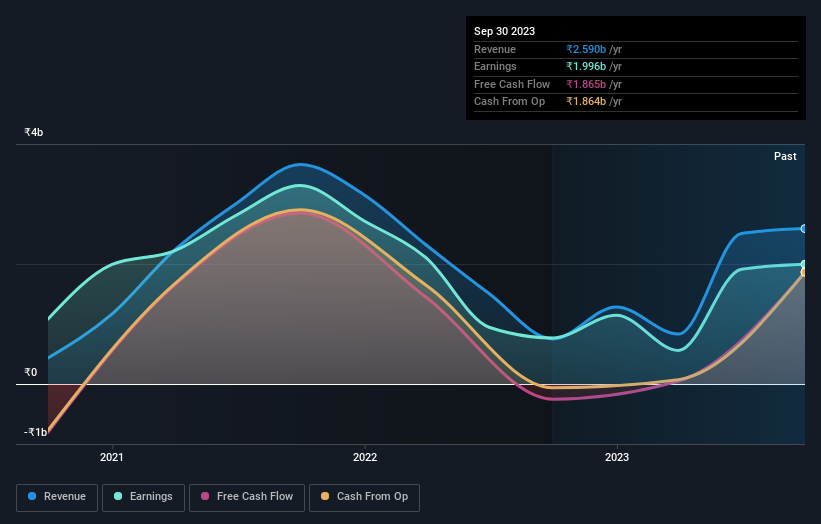- India
- /
- Capital Markets
- /
- NSEI:VLSFINANCE
Individual investors among VLS Finance Limited's (NSE:VLSFINANCE) largest shareholders, saw gain in holdings value after stock jumped 30% last week
Key Insights
- The considerable ownership by individual investors in VLS Finance indicates that they collectively have a greater say in management and business strategy
- A total of 6 investors have a majority stake in the company with 51% ownership
- 15% of VLS Finance is held by insiders
If you want to know who really controls VLS Finance Limited (NSE:VLSFINANCE), then you'll have to look at the makeup of its share registry. And the group that holds the biggest piece of the pie are individual investors with 44% ownership. In other words, the group stands to gain the most (or lose the most) from their investment into the company.
As a result, individual investors collectively scored the highest last week as the company hit ₹9.7b market cap following a 30% gain in the stock.
In the chart below, we zoom in on the different ownership groups of VLS Finance.
View our latest analysis for VLS Finance

What Does The Institutional Ownership Tell Us About VLS Finance?
Institutional investors commonly compare their own returns to the returns of a commonly followed index. So they generally do consider buying larger companies that are included in the relevant benchmark index.
Since institutions own only a small portion of VLS Finance, many may not have spent much time considering the stock. But it's clear that some have; and they liked it enough to buy in. So if the company itself can improve over time, we may well see more institutional buyers in the future. When multiple institutional investors want to buy shares, we often see a rising share price. The past revenue trajectory (shown below) can be an indication of future growth, but there are no guarantees.

VLS Finance is not owned by hedge funds. The company's largest shareholder is VLS Capital Limited, with ownership of 38%. With 5.7% and 2.5% of the shares outstanding respectively, Mahesh Mehrotra and Sadhana Mehrotra are the second and third largest shareholders. Mahesh Mehrotra, who is the second-largest shareholder, also happens to hold the title of Senior Key Executive.
On further inspection, we found that more than half the company's shares are owned by the top 6 shareholders, suggesting that the interests of the larger shareholders are balanced out to an extent by the smaller ones.
While studying institutional ownership for a company can add value to your research, it is also a good practice to research analyst recommendations to get a deeper understand of a stock's expected performance. As far as we can tell there isn't analyst coverage of the company, so it is probably flying under the radar.
Insider Ownership Of VLS Finance
The definition of company insiders can be subjective and does vary between jurisdictions. Our data reflects individual insiders, capturing board members at the very least. Management ultimately answers to the board. However, it is not uncommon for managers to be executive board members, especially if they are a founder or the CEO.
I generally consider insider ownership to be a good thing. However, on some occasions it makes it more difficult for other shareholders to hold the board accountable for decisions.
Our most recent data indicates that insiders own a reasonable proportion of VLS Finance Limited. It has a market capitalization of just ₹9.7b, and insiders have ₹1.5b worth of shares in their own names. It is great to see insiders so invested in the business. It might be worth checking if those insiders have been buying recently.
General Public Ownership
The general public, who are usually individual investors, hold a 44% stake in VLS Finance. This size of ownership, while considerable, may not be enough to change company policy if the decision is not in sync with other large shareholders.
Private Company Ownership
Our data indicates that Private Companies hold 40%, of the company's shares. Private companies may be related parties. Sometimes insiders have an interest in a public company through a holding in a private company, rather than in their own capacity as an individual. While it's hard to draw any broad stroke conclusions, it is worth noting as an area for further research.
Next Steps:
While it is well worth considering the different groups that own a company, there are other factors that are even more important. Consider for instance, the ever-present spectre of investment risk. We've identified 2 warning signs with VLS Finance , and understanding them should be part of your investment process.
Of course, you might find a fantastic investment by looking elsewhere. So take a peek at this free list of interesting companies.
NB: Figures in this article are calculated using data from the last twelve months, which refer to the 12-month period ending on the last date of the month the financial statement is dated. This may not be consistent with full year annual report figures.
New: Manage All Your Stock Portfolios in One Place
We've created the ultimate portfolio companion for stock investors, and it's free.
• Connect an unlimited number of Portfolios and see your total in one currency
• Be alerted to new Warning Signs or Risks via email or mobile
• Track the Fair Value of your stocks
Have feedback on this article? Concerned about the content? Get in touch with us directly. Alternatively, email editorial-team (at) simplywallst.com.
This article by Simply Wall St is general in nature. We provide commentary based on historical data and analyst forecasts only using an unbiased methodology and our articles are not intended to be financial advice. It does not constitute a recommendation to buy or sell any stock, and does not take account of your objectives, or your financial situation. We aim to bring you long-term focused analysis driven by fundamental data. Note that our analysis may not factor in the latest price-sensitive company announcements or qualitative material. Simply Wall St has no position in any stocks mentioned.
About NSEI:VLSFINANCE
Adequate balance sheet second-rate dividend payer.
Market Insights
Community Narratives




